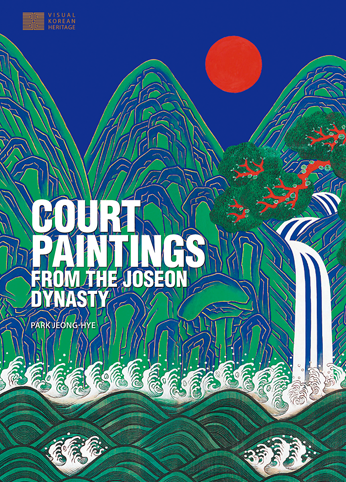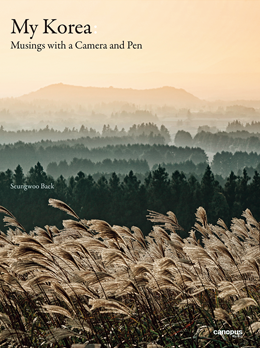Elegant Presentation of Joseon Court Paintings
“Court Paintings from the Joseon Dynasty”
By Park Jeong-hye, 167 pages, $37.00, Seoul: Seoul Selection (2016)
This is the first volume in the Visual Korean Heritage series, “a collection of Korea’s traditional culture and arts, in particular pieces that display visual intensity or embody the Korean idea of beauty.” The goal of this series is to place the spotlight on the works of art themselves and provide brief explanations to aid the reader in better understanding the arts of Korea. “Court Paintings from the Joseon Dynasty” certainly achieves this goal, as the first thing the reader will notice upon opening up this beautifully printed book is the great number of pages devoted to reproducing the paintings. With the exception of the back matter, the book devotes four-fifths of its page space to showcasing 30 noteworthy court paintings.
A three-page introduction to the collection guides the reader into the world of Joseon court paintings, discussing their functions, genres, and motifs. This is the longest passage of text in the book, though; the 30 works covered are each accompanied by brief explanations. Each painting is allowed several pages, with one or two pages for the full version and at least one more page for details that have been enlarged to occupy the entire page.

The treatment of the first painting — fittingly a portrait of King Taejo, founder of the Joseon Dynasty (1392–1910) — is characteristic of the book as a whole. On the left is the full portrait of the king, known to anyone who is even passingly familiar with Joseon paintings. The right page has three paragraphs that discuss the history, style, and artistic and cultural elements of the painting. Turn the page, though, and we are met with a close-up of Taejo’sface. Clearly visible are the wrinkles and creases around his eyes, the individual strands of hair in his mustache and beard, and even a wart on his forehead (a feature this reviewer never knew existed, having only ever seen the painting from a distance or on a smaller scale). On theright is an enlargement of the lower left corner of the painting, bleedingto the very edge of the page, which reveals the exquisite detail paintedinto the dragons on the king’s throne. Each painting is afforded thesame care and attention, and some even more — two pages (65 and 97)fold out, allowing for detailed presentation of four very wide paintingsthat would otherwise not have been possible in book format.
The text, while kept to a minimum, is knowledgeable and informative.If there is any quibble with the book, though, it would be here. Thetext is by and large mechanically correct, but it is unfortunately marredby the occasional awkward turn of phrase or word choice.
These blemishesare not so glaring as to impede understanding, and it does seemsomewhat petty to mention such fault, but the blemishes were all themore noticeable when juxtaposed with the beautifully rendered paintings.
The quibble aside, this is a beautiful book that achieves what it setsout to do. While other art books may shoehorn smaller versions ofpaintings into pages of text, or at best set aside a page or two for a fullpainting, this book understands that the star of the show is the art. Ifthis is representative of the series as a whole, then Visual Korean Heritagewill become a collection that any lover of Korean art will want ontheir shelves.
An Intimate Guide to Life in Korea
“My Korea: Musings with a Camera and Pen”
By Baek Seung-woo, 248 pages, 20,000 won, Seoul: Canopus (2015)

What this book is not is anindexed guidebook to Korea ora coffee table book with stunningphotos.
“My Korea: Musings witha Camera and Pen” is exactlywhat the title says it is: a collectionof personal observationsand opinions and photographsof places the author hasvisited. Baek Seung-woo hasworked in the hotel industry for30 years as a finance officer,during which time he becameacquainted with what foreigners — travelers and residents alike —find curious about life in Korea.
While the author concedes that he is not a professional writer, ithas not deterred him from publishing books. His first effort, a photoessay book in Korean titled “Way to Work, Yaksudong Street” waspublished in 2013. This latest book is in English, which is not hisnative language.
In the book’s preface, Baek explains how the project got started:as Facebook postings, in English, on Korean customs with foreign readers in mind. The book is a collection of those postings with awide selection of photographs taken by the author, both in color andblack-and-white.
The book begins with an entry dated September 21, 2015, “TheHistorical Name of Korea.” Baek explains the origin of “Korea,” howit is an eponym derived from the Goryeo period (918–1392). Exploringthe various names of the country in the modern period seems afitting start to a book that purports to explain the country.
Presented in a reverse chronological order, the entry on thelast page, dated August 13, 2013, is a single paragraph on businesslunches in Korea. Here the author recommends naengmyeon(cold noodles), vegetable dishes, and samgyetang (ginseng chickensoup).
This curious arrangement explains why the entries becomeshorter and the language grows less fluid, even awkward. Indeed,this book is proof that regular journaling is a surefire way toimprove one’s writing. It is easy to appreciate the progress theauthor made in the two years that he dedicated to this undertaking.The book could have benefited from tighter editing and moremeticulous proofreading, but it still engages the reader in an intimateway. If you get past the strangeness of some of the sentencestructures, the book can be enjoyed anyway you want. It can serveas a personal guide on a journey to discover Korea’s culture, people,customs, and everyday life.
The book does not have to be read front to back as it is notarranged thematically. Opening a random page and discoveringsomething unexpected might just be the best way to appreciate it.
Gold Mine of Data about Korea’s Cultural Heritage
http://www.nrich.go.kr/english_new/
The English-language website of the National Research Instituteof Cultural Heritage includes a database of some 150,000 Koreancultural properties, both in and outside the country, making the sitean indispensable resource for those studying Korea.
The website is presented in a succinct manner, with well-writtentext and attractive visuals. It is also user-friendly with clear,simple organization, making it easy to navigate. Even a laypersonwho seeks to access information on Korea’s rich cultural heritage,including natural heritage, will find the website informative andeducational.
For researchers, the most useful feature of the website may bethe searchable “Database” section where the various reports publishedby the National Research Institute of Cultural Heritage areavailable. This section also contains video and audio files and slides,as well as “Journal of Korean Archaeology.”
English-language abstracts of reports issued in Korean by the institute are available, some in PDF format. As this is an Englishlanguagewebsite, a more prominent display of the section on culturalproperties located outside Korea would have been appreciated,however.
It is regrettable that, as is often the case with foreign languagewebsites of Korean organizations, some sections have not beenupdated. For example, the most recent international seminar listedis from 2012, though the seminars are held annually. It should alsobe noted that at the timeof writing, the CulturalHeritage Knowledge Portalcould not be accessedthrough the “shortcut”provided on the website.
Although with similarproblems and room forimprovement, the institutealso operatesChinese- and Japaneselanguagewebsites.